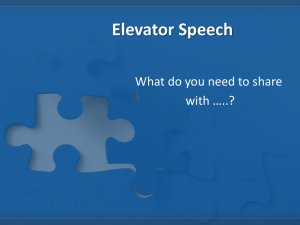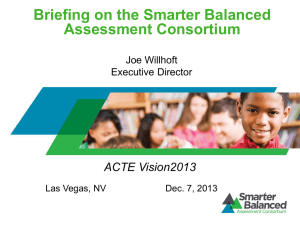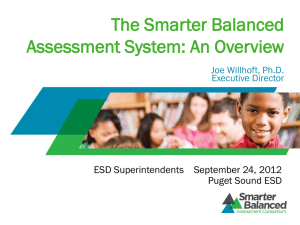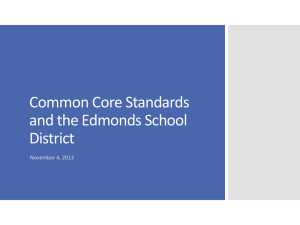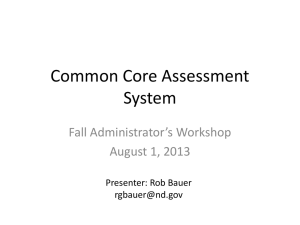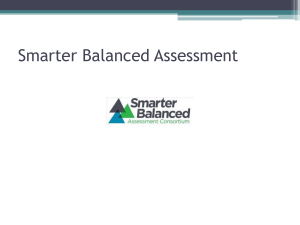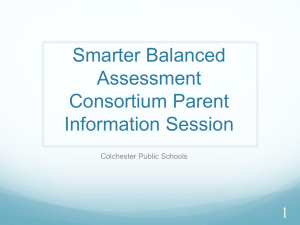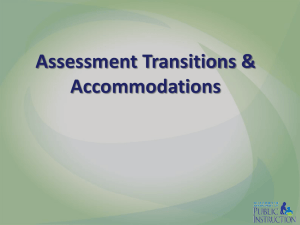Smarter Balanced Presentation: Louise Feroe (ppt)
advertisement
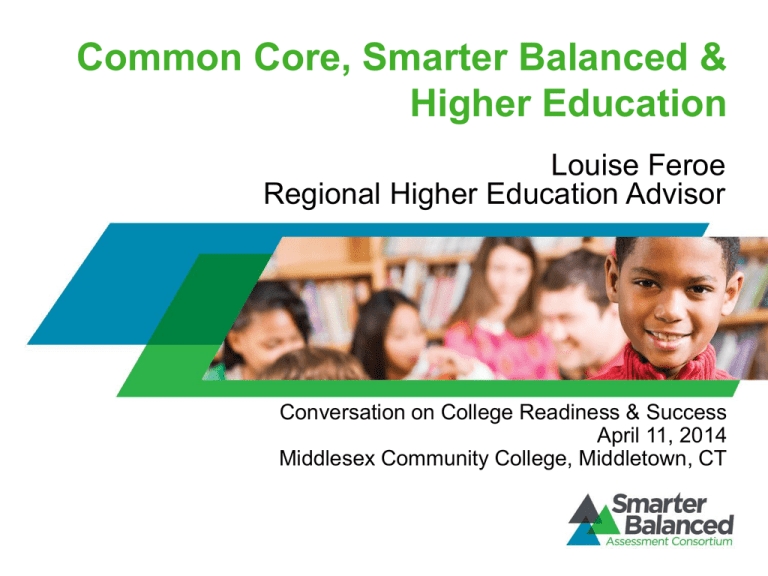
Common Core, Smarter Balanced & Higher Education Louise Feroe Regional Higher Education Advisor Conversation on College Readiness & Success April 11, 2014 Middlesex Community College, Middletown, CT About Common Core From School to College: A Bridge Built from Two Distant Shores Common Core: A Coherent Blueprint • Built to a new specification: College and career readiness for all students – English language arts: reading increasingly complex literary and informational texts, persuasive writing, research, academic speaking and listening skills, and use of language. – Math: deep conceptual understanding, procedural fluency, application of mathematics to solving challenging real-world problems, ability to explain and defend reasoning • Designed collaboratively by K-12 and higher education faculty • Benchmarked to top international standards (Hong Kong, Singapore, Finland) Don’t Take My Word For It! • Download the standards at www.CoreStandards.org • Visit www.AchieveTheCore.org for sample lesson plans, tasks and assessments, and additional explanatory materials designed for teachers and school leaders. You Are Not Alone About Smarter Balanced What is Smarter Balanced? • A consortium of 26 states and territories working together to build next-generation formative, interim and summative assessments for K-12 schools tied to the Common Core State Standards in English language arts/literacy and mathematics. • Funding from the federal Race to the Top Assessment grant (~$175M) and foundations (~$3M). • Governed by member states on a consensus model. Smarter Balanced Assessment Consortium • • 26 states & territories (22 governing, 3 advisory, 1 affiliate) K-12 & Higher Education Leads in each state A Balanced Assessment System Common Core State Standards specify K-12 expectations for college and career readiness Summative assessments Benchmarked to college and career readiness Teachers and schools have information and tools they need to improve teaching and learning Teacher resources for formative assessment practices to improve instruction Interim assessments Flexible, open, used for actionable feedback All students leave high school college and career ready Purposes and Users for the Summative Assessments Grades Tested Purpose User School/District/State Accountability Federal ESEA/NCLB 11 Student Readiness for Creditbearing College Coursework Higher Education Institutions 9, 10, 12 State Designed End-of-Course, Graduation Requirements, etc. State Option 3-8 and 11 Teacher/Principal Accountability State/District Option 3-8 and 11 Summative Assessment: Two-pronged Approach Computer Adaptive Test • Assesses the full range of Common Core in English language arts/literacy and mathematics for students in grades 3-8 and 11 (interim assessments can be used in grades 9 and 10) • Measures current student achievement and growth across time, showing progress toward college and career readiness • Includes a variety of question types: selected response, short constructed response, extended construction response, technology enhanced Performance Tasks • Extended projects demonstrate realworld writing and analytical skills • May include online research, group projects, presentations • Require 1 to 2 class periods to complete • Included in both English language arts/literacy and mathematics assessments • Applicable in all grades being assessed • Evaluated by teachers using consistent scoring rubrics Summative Assessment: Benefits and Limitations Benefits • Far more sophisticated and comprehensive measure of student knowledge and skills than existing K-12 college placement exams. • Linked to known, high-quality content standards (Common Core). • Early warning for students not yet college ready. Limitations • Summative exams are not diagnostic in nature. • Will not measure readiness for advanced mathematics (e.g. Calculus) requiring 12th grade instruction. Don’t Take My Word for It Practice Tests for all grades and both subjects available at www.SmarterBalanced.org Smarter Balanced and Higher Education Why is Higher Education Involved in Smarter Balanced? • Common Core State Standards are anchored in expectations for college readiness. • Higher education agreed when states applied for federal grant to participate in design of assessments with the goal of recognizing 11th grade exam as evidence of college content- readiness. • Opportunity to improve college readiness, encourage enrollment, reduce remediation, improve lower division courses, and boost completion. Common Core Standards and Assessments: Essential Components of Access & Completion Research has consistently shown that the single most powerful predictor of student success in college is the rigor of academic preparation. Common Core standards and assessments: • Anchor K-12 experience in real-world expectations for success in college and careers. • Remove guesswork for teachers and schools. • Allow schools, parents and students to track progress. • Identify students who need assistance while still in high school. • Create opportunities for early outreach and encouragement. • Reduce remediation and increase college success. A New Vision for Assessing Readiness Typical Readiness Testing Today • Each college or system sets its own standards and selects its own measures. • K-12 typically has no information about the standards. • Students don’t know about tests and don’t prepare for them. • Predictive validity of tests is often unknown. • Students who “played by the rules” end up in remediation. Smarter Balanced Vision • Assessments designed around known, agreedupon standards (Common Core). • Performance standards set through an open process with substantial higher education involvement. • Everyone (students, teachers, parents, etc.) knows the expectations. • Students address deficiencies in high school. Smarter Balanced Goals for Higher Education • • • Colleges and universities recognize the Smarter Balanced Grade 11 assessment as a valid measure of college content-readiness as defined by the Common Core State Standards. Colleges and universities agree on a common performance standard in English language arts/literacy and mathematics for college content-readiness. Colleges and universities use the Smarter Balanced assessment as evidence that students are ready for credit-bearing course work and can be exempted from developmental courses. Reaching the Goal: Expectations of Higher Education What is Expected What is NOT Expected • Participation in assessment design • Lead role in defining college readiness and setting performance standards for 11th grade assessment • Agreement on performance standards for exemption from developmental courses in English and math • Use of Smarter Balanced assessment for admission • Standardization of admission criteria or standards • Standardization of developmental or first-year curricula • Complete reliance on the Smarter Balanced assessment for placement decisions (other data points and assessments may be used) College Content-Readiness Policy What is Content Readiness? English Students who perform at the College Content-Ready level in Language English language arts/literacy demonstrate reading, writing, Arts/Literacy listening, and research skills necessary for introductory courses in a variety of disciplines. They also demonstrate subject-area knowledge and skills associated with readiness for entry-level, transferable, credit-bearing English and composition courses. Mathematics Students who perform at the College Content-Ready level in mathematics demonstrate foundational mathematical knowledge and quantitative reasoning skills necessary for introductory courses in a variety of disciplines. They also demonstrate subject-area knowledge and skills associated with readiness for entry-level, transferable, credit-bearing mathematics and statistics courses. Policy Framework for Grade 11 Assessment Results Level 1 • Not Yet Content-Ready - Substantial Support Needed • K-12 & higher education may offer interventions Level 2 • Not Yet Content-Ready – Support Needed • Transition courses or other supports for Grade 12, retesting option for states Level 3 • Conditionally Content-Ready/Exempt from Developmental • In each state, K-12 and higher ed must jointly develop Grade 12 requirements for students to earn exemption Level 4 • Content-Ready/Exempt from Developmental • K-12 and higher education may jointly set Grade 12 requirements to retain exemption (optional for states) Note: Applies only to students who matriculate directly from high school to college. Higher Education After Smarter Balanced: What’s Changed? • • • • • • Instead of multiple tests, with differing performance standards, all public schools in consortium states use the same test, content standards (Common Core) and performance standards. Grade 11 performance standards are pegged to college contentreadiness, with standards for earlier grades mapped to Grade 11. In each state, K-12 and higher education set requirements for Grade 12 (may vary by institution type). Students, parents and teachers know where the academic “goal line” is and students can address deficiencies in high school. Working together, K-12 and higher education can develop appropriate grade 12 experiences for students at differing achievement levels. Colleges can target students for special programs based on Grade 8 scores (or earlier). Assessments and Validation • Cut scores and grade 12 expectations – How much variability is there now within each state by campus, discipline, system? Where is authority to reach agreement? – Common cut scores on the assessments plus state-set Grade 12 will expectations will signal eligibility for credit bearing work at the college level. How will cut scores be set? Who will contribute? How will K12 and higher education jointly determine Grade 12 expectations? How will all this be communicated? • Validation – Timing, consultation, validation for first year of college as well as high school readiness? Exemplar Student Scenarios [To be determined by states] Maria earns Level 4 on the math assessment. She wants to take Calculus in college so she will take pre-calculus as a senior and may take a placement test when she arrives at college. Jason earns Level 3 on the math assessment. To be exempt from developmental courses, he has to take Statistics or Trigonometry in Grade 12 and earn a grade of B or better. Kathy earns Level 2 on the math assessment. Her high school offers her an intensive math course with the local community college. Near the end of Grade 12, she will either retake the Smarter Balanced exam or a take a college placement test. Higher Education After Smarter Balanced: What Hasn’t Changed? • • • • • High school exit: Some states may use the Smarter Balanced assessment—with a lower performance standard—for high school exit, but no state currently plans to use the college content-readiness standard for this purpose. Admission : Colleges will continue to admit students according to their current standards and practices – the college content-readiness policy applies only to admitted students. Placement: While honoring the exemption from developmental education for students who have earned it, colleges may use tests (and/or other means) to determine appropriate course placement. Dev ed reform: Colleges can continue to place any student into creditbearing courses. Grades-only placement policies are unaffected. STEM: Colleges will need to assess additional evidence for students seeking to enter more advanced mathematics courses. High school/postsecondary transitions Bridge strategies to address remedial needs in the senior year – Need assessment for likely volume (how many more students)? – Are courses in place? Are instructors ready? – Consequences for other senior year courses/sequencing? Options to accelerate college-going and credit for seniors who show readiness – Early college high schools – College credit via assessments, AP, IB – Is volume ready to meet demand? First year college curriculum changes – What should be in place and when? – Relationship to ongoing efforts in core curriculum reform and outcomes-based assessment (ex: DQP efforts)? Next Steps for Higher Education States Determine Grade 12 Requirements Fall 2013 – Spring 2014 Validation Research Implementation Spring 2014 – 2017 Standard-setting* October, 2014 Institutional participation decisions Beginning Fall 2014 * Subject to state vote by K12 and higher education. Working Together to Increase Student Success Smarter Balanced Assessment K-12 Priorities Higher Ed Priorities Statewide Aspirations Collaboration is tricky business Learn More and Stay Engaged • Visit SmarterBalanced.org for the latest news and developments • Sign up for the enewsletter • Follow on Twitter: @SmarterBalanced
